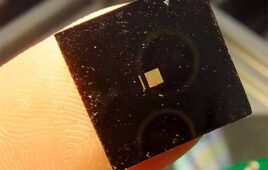
Mouse heart cells grown on graphene beat at a rate controlled by light stimulation. [Image courtesy of UC San Diego]
The heart cells are being grown in graphene which turns light into electricity, a more realistic environment that traditional plastic or glass laboratory dishes. The researchers suggest that the method could be used in a number of research and clinical applications including testing therapeutic drugs, developing use-specific drugs that are more precise and have fewer systemic effects and create better medical devices like light-controlled pacemakers.
“When we first got this working in our lab, suddenly we had something like 20 people gathering around, shouting things like ‘Impossible!’ and accusing me of pranking them. We’d never seen anything like this before,” Alex Savchenko, a research scientist at UCSD and the study’s first author, said in a press release.
Graphene is a semi-metal that has a latticework of carbon atoms, which is the same element that makes the basis of all living organisms. It has the ability to efficiently convert light into electricity whereas glass and plastic are insulators and don’t conduct electricity. According to the researchers, most biological research relies on individual cells or cell cultures to be grown in plastic or glass petri dishes and plates. The researchers noticed that cells grown better in a lab when grown on graphene than any other material and behave more like cells in the body.
“Yet in your body, you don’t see many surfaces acting like plastic or glass,” Savchenko said. “Instead, we’re conductive. Our hearts are extremely good at conducting electricity. In the brain, it’s electric conductivity that allows me to think and talk at the same time.”
The researchers generated heart cells from donated skin cells through an intermediary cell type called the induced pluripotent stem cell (iPSC). The researchers could then grow the iPSC-derived heart cells on a graphene surface.
However, Savchenko said that it took some time to figure out the optimal graphene-based formulation. They had to find the best light source and the way to deliver the light to the graphene-cell system. They eventually figured out how to precisely control how much electricity the graphene was generating by changing the intensity of the light.
“We were surprised at the degree of flexibility, that graphene allows you to pace cells literally at will,” Savchenko said. “You want them to beat twice as fast? No problem — you just increase the light intensity. Three times faster? No problem — increase the light or graphene density.”
The researchers further tested the method and found that they could control heart activity in zebrafish embryos using light and dispersed graphene. They were also surprised and the lack of toxicity.
“Normally, if you introduce a new material in biology, you’d expect to see a certain number of cells killed in the process,” Savchenko said. “But we didn’t see any of that. It makes us hopeful that we’ll be able to avoid harmful problems later on, as we test various medical applications.”
The graphene/light system has the potential to be used in a number of medical applications, according to the researchers. For example, researchers could use the method in drug screening by testing drugs on heart cells grown in graphene. The researchers tested the drug screening by adding mexiletine, a medication that treats irregular heartbeats, to their heart cells. Since the medication is known to have an effect when there is an increased heart rate, the researchers illuminated the heart cells on graphene with different intensities to see how well the mexiletine worked. Each time the heart cells beat faster, the mexiletine worked to inhibit them.
Savchenko and his researchers are currently focusing their research on heart cells and neurons, but they hope to further develop the system to test drugs that kill cancer cells and leave healthy cells alone. They also hope to use graphene to find opioid alternatives. Savchenko also thinks that graphene pacemakers controlled by light could be more safe and effective than current pacemaker models.
The research was published in the journal Science Advances and was funded by the National Institutes of Health, the National Science Foundation and the American Heart Association.




